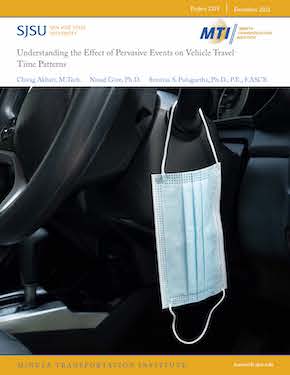- 408-924-7560
- mineta-institute@sjsu.edu
- Donate
Understanding the Effect of Pervasive Events on Vehicle Travel Time Patterns
The COVID-19 pandemic has disrupted daily activities and travel patterns, affecting personal and commercial trips. This study investigates the effect of different stages of the pandemic on travel time patterns. Eighty-six geographically distributed links (sections of road) in Mecklenburg County and Buncombe County, North Carolina, were selected for analysis. The selected links accounted for the variation in road geometry, land use, and speed limit. Travel time data for three years (i.e., 2019, 2020, and 2021) were extracted from a private data source at 5-min intervals. Travel time reliability (TTR) and travel time variability (TTV) are estimated for different phases of the pandemic and compared to analyze the effect of COVID-19 on TTR and TTV. The seasonal arithmetic integrated moving average (SARIMA) model was developed to investigate the effect of COVID-19 on average daily travel time patterns. Unreliable and uncertain travel times were observed on lower speed limit links during the off-peak hours while reliable and certain travel times were observed during morning and evening peak hours of the COVID-19 pandemic. This highlights that the COVID-19 pandemic significantly affected the scheduling of trips. For higher speed limits, travel times were reliable and certain during off-peak and peak hours. Among the different phases of COVID-19, significant improvement in TTR and TTV was observed during Phase II, which could be attributed to stay-at-home directives. Trucks followed a similar pattern as passenger cars. Post-COVID-19, i.e., for 2021, travel times were reliable and certain for most links during the morning peak hours. The SARIMA model revealed a significant effect of COVID-19 on average daily travel time patterns. Stable travel time patterns were noted during Phase II of COVID-19. Moreover, a maximum reduction in travel time was observed during Phase II of the COVID-19 pandemic. The findings emphasize the influence of government norms and regulations on travel time patterns during pervasive events such as COVID-19.
CHIRAG AKBARI, MTECH
Mr. Akbari is pursuing his Ph.D. in Civil Engineering at the University of North Carolina at Charlotte. His areas of interest are traffic operations, simulation modeling, and the application of unconventional designs.
NINAD GORE, PHD
Dr. Gore is currently working as a postdoctoral researcher of the Department of Civil and Environmental Engineering at the University of North Carolina at Charlotte. His research interests include traffic conflict-based safety evaluation, traffic flow theory and modeling, travel behavior, and the application of econometric and machine learning models to transportation.
SRINIVAS S. PULUGURTHA, PHD, PE, FASCE
Dr. Pulugurtha is currently working as a professor and research Director of the Department of Civil and Environmental Engineering at the University of North Carolina at Charlotte.
-
Contact Us
San José State University One Washington Square, San Jose, CA 95192 Phone: 408-924-7560 Email: mineta-institute@sjsu.edu






